In this blog, I’m going to discuss blue crayfish and blue crayfish care.
They are truly amazing and curious animals, and that is probably why many people keep them as pets, besides the fact that their color is gorgeous and mesmerizing, as you will see from the pictures in this post.
Table of Contents:
- Blue Crayfish Intro
- Where Blue Crayfish are From
- What Causes a Blue Crayfish’s Coloring
- The Temperament of Blue Crayfish
- The Lifespan of “Florida Crayfish”
- What Blue Crayfish Eat
- Blue Crayfish and Molting
- Keeping Blue Crays as Pets
- The Crayfish Tank
- Water Changes
- Plants and Blue Crayfish
- Multiple Crayfish and Tank Size
- Hideouts
- Your Crayfish and Babies
- Tankmates
- Mineral Supplements
- Crayfish Fighting
- Regenerating Body Parts
- Living Outside of Water
- Recap
Blue Crayfish: The Ultimate Guide to a Beautiful and Interesting Animal
| Quick Facts on Blue Crayfish | |
|---|---|
| Scientific Name: | Procambarus alleni |
| Origin: | Florida |
| Temperament: | Aggressive |
| Care Level: | Beginner |
| Eating Type: | Omnivore |
| Minimum Tank Size: | 20-gallon (Suggested) |
| Feeding: | Sinking algae pellets, vegetables, bloodworms |
| Interesting Fact: | Can regenerate limbs |
Which unfortunately has sometimes led to situations that ended badly. Yes, I’ve lost a fish or two in the early days of keeping my crayfish.
I’ll admit, I originally bought my blue crayfish because of its unreal blue color.
When I first saw him in a tank at a local pet store, I honestly had a hard time believing that the color was natural.
Their blue color is so vivid and bright, many people often question my Instagram pictures and other pictures on social media, even when I post them without using any filters.
Today, I realize that there is much more to these little creatures than just their stunning appearance.
I’ve learned a lot more about them by watching them over the years, and in this guide, I hope to give you information that will help you learn about the blue crayfish and how to care for them.
1. Where Blue Lobsters are From
Blue crayfish are originally from the gorgeous and very warm state of Florida. In Florida, they are often found in the St. Johns River and in the Florida Keys.
But, electric blue crayfish, also known as blue lobsters, Florida crayfish, and blue crawfish, can also be found in West Virginia, Pennsylvania, Maryland, Kentucky, Virginia, Tennessee, and North Carolina.
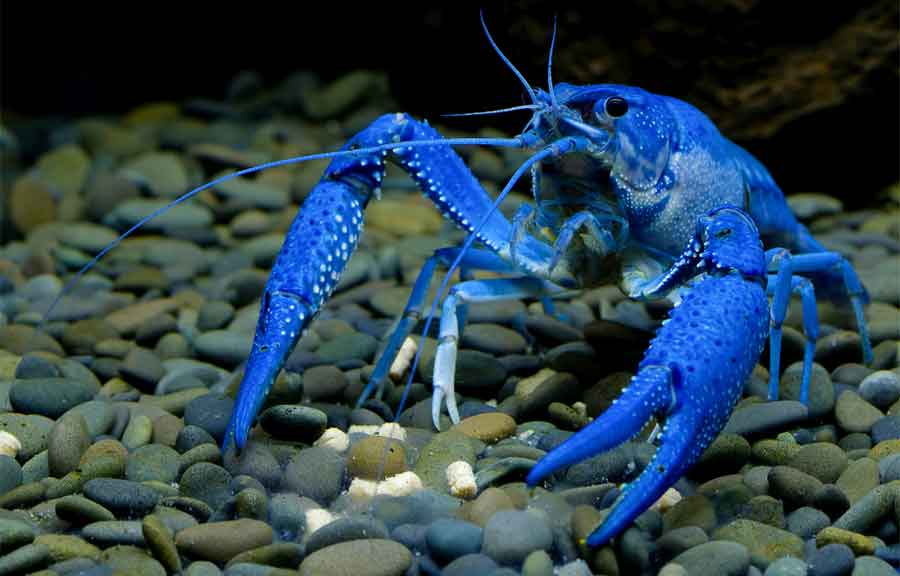
Also, in May of 2020, The Ohio Division of Wildlife announced they discovered a new species of blue crayfish in Monroe County, Ohio. It is a gorgeous and bold blue color.
States Where Blue Crayfish Can be Found
- Florida
- Kentucky
- Maryland
- North Carolina
- Ohio
- Pennsylvania
- Tennessee
- Virginia
- West Virginia
2. Where Florida Crayfish’s Blue Color Comes From
This is a very common question about the stunning blue crayfish—where does the blue color come from?
Basically, the blue color is caused by a genetic mutation.
According to scientists, these particular crays lack a gene that causes their beautiful coloring. Yes, it’s a defect that is responsible for them being so alluring and appealing.
You will notice, though, that not all blue crayfish have the same blue colors. Some may be more brightly colored than others.
Things like diet, environment, and water conditions may be the reason for this.
3. The Blue Crayfish’s Aggressive Temperament
Crayfish are pretty darn aggressive.
After having kept Florida crayfish as pets for years, I’ve experienced and learned a lot by watching these unique creatures for myself.
These animals will eat the other fish in your fish tank if given the opportunity. They will also fight and eat other crayfish as I have witnessed firsthand with my first crayfish (watch the video below).
Even though blue crays do have a very aggressive nature, though, this does not mean they can’t be kept with other freshwater fish in a fish tank.
Factors such as the size of your fish tank and the types of fish you keep with your crayfish can be huge determinants in the success of your aquarium.
These things can decide whether or not your aquarium becomes a peaceful community tank with other fish and can also determine if it becomes a feeding tank for your crayfish. But, more on these points in a minute.
4. The Lifespan of Blue Crayfish
In captivity, when properly cared for, these bright blue scavengers can live for about three to six years. Six years is a long time for a crayfish, but, lifespans of different crayfish can vary significantly.
To maximize the lifespan of your crayfish, however, you’ll really want to focus on the care of your crayfish. I’ll discuss this in more detail below.
5. What Crayfish Eat
Crayfish are scavengers. They are omnivores and will eat both plants and animals. In short, they will eat almost anything. Let’s not kid ourselves here.
In the wild, these little crustaceans roam about eating virtually anything they can get between their claws. This means they will eat both live and dead animals such as fish and insects, and they will also eat plants (more on that later).
When living in captivity, crayfish can be fed vegetables such as peas, carrots, spinach, and zucchini. They can also be fed sinking algae tablets, brine shrimp, and bloodworms to make things easier.
Blue crayfish are not picky when it comes to food.
What to Feed Your Pet Blue Crayfish?
- Sinking algae pellets
- A variety of vegetables (cucumber, carrots, peas)
- Brine shrimp
- Bloodworms
6. Crayfish and Molting
As crayfish grow, they shed their exoskeletons. This process is known as molting.
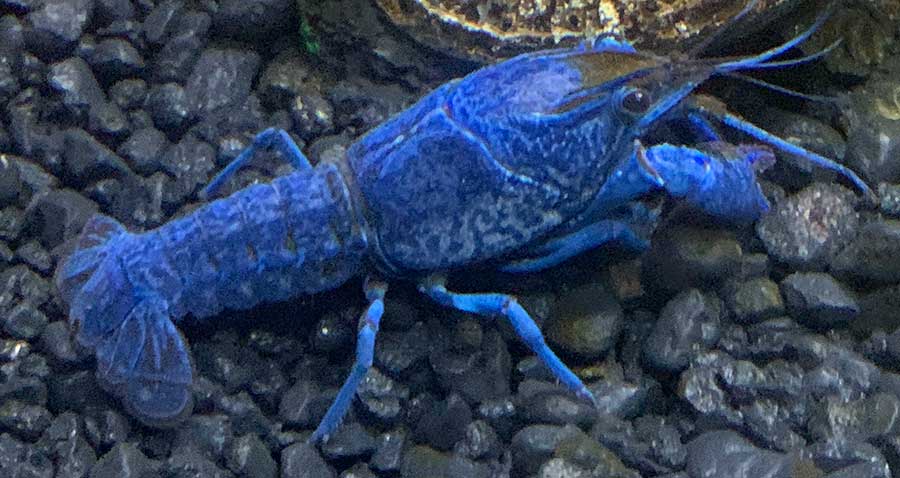
When crayfish are about to molt, oftentimes they will stop eating, and hide while they shed their exoskeleton. Immediately after shedding their blue exoskeletons, crayfish become weak and vulnerable, especially to other fish. It’s for this reason that when keeping crays as pets, keepers should also place “hideouts” in their tanks (more on this below).
It’s also very important that keepers do not remove the exoskeleton from the tank after a cray molts. Crays will eat their exoskeleton after molting. This helps make a crayfish’s new exoskeleton stronger and healthier.
How Often Do Crayfish Molt?
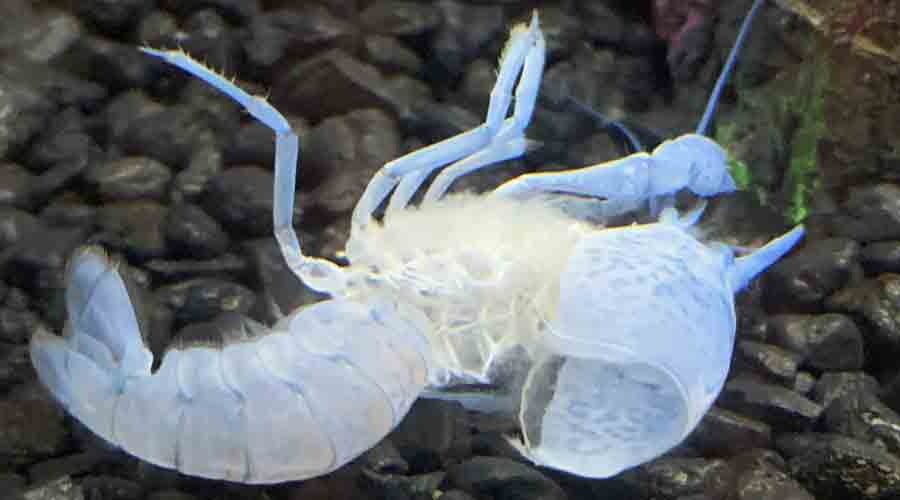
In the first year, crayfish can molt up to about 10 times. Each time growing a little bigger than before.
As crayfish get older though, they will only molt a fraction of the times they did when they were younger.
7. Tips for Keeping a Blue Crayfish as a Pet
Yes, these guys are pretty easy to keep as pets. Again, they eat almost anything you feed them, are hardy animals, and don’t require much labor-intensive care.
However, when keeping these guys as pets, you will want to follow a few crayfish keeping guidelines.
A. The Fish Tank for Your Blue Crayfish
These bright blue Florida crayfish like to roam a good bit, so give them a tank that is big enough to do so. Plus they put out a lot of waste, so a bigger tank makes things easier to manage.
I’d suggest nothing smaller than a 20-gallon aquarium. Yes, smaller tanks can work okay, but I’ve seen from my experience that a 20-gallon tank is probably the best option. Also, if you get a tank that is too small, these guys can skip town and escape. I’ve also seen this happen.
Tank Placement
You’ll also want to be careful with where you place your crayfish tank. Putting any fish tank in the direct line of sunlight can cause an overgrowth of algae.
Substrate
As far as substrate and your blue crayfish, I’d highly suggest sand or very fine gravel.
If you really want your blue crayfish to look more amazing than he already does, use black sand or gravel. It will make that bright blue color pop.
Pro tip: Before placing your crayfish into a tank, be sure to add conditioned water and cycle the tank.
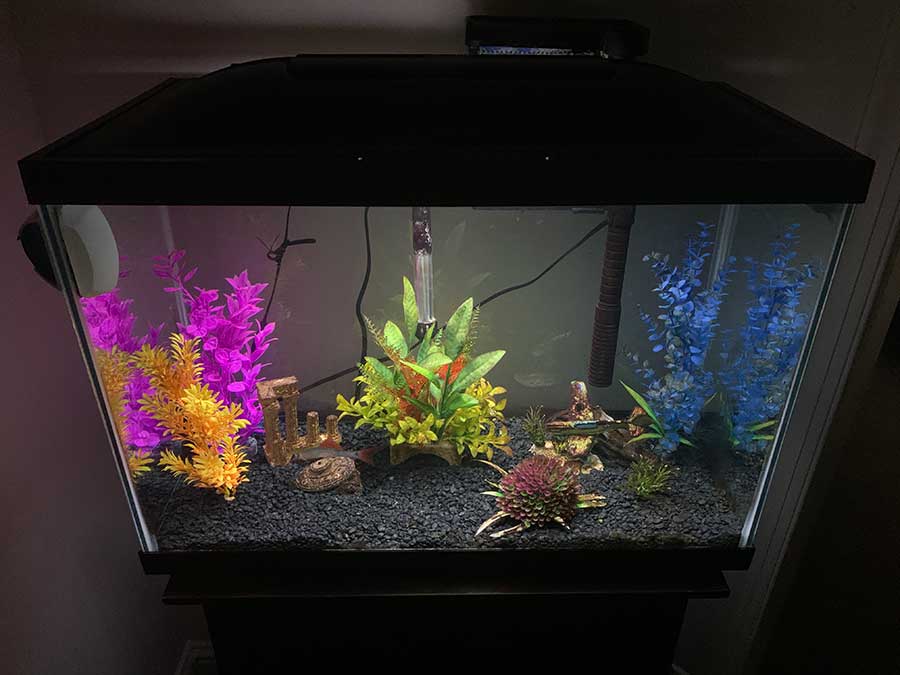
B. Do Frequent Water Changes
Crayfish are dirty animals. They love to eat, and with that, they put out a lot of waste. Because of this, it’s essential to clean your fish tank and to do regular water changes in your aquarium so that your tank doesn’t become toxic and unhealthy. This will also keep your tank looking great, and your crayfish and other aquatic life healthy and happy.
Additionally, the water temperature should be kept between 70 to 75 degrees. And you want to make sure the pH is around 7, which is neutral.
As you clean your tank, make it a point not to scrub the decorations, plants, and hideouts that are in your fish tank. These items contain beneficial bacteria that help neutralize and eliminate toxins in your aquarium.
Pro tip: There are a lot of variables that can determine the frequency of water changes and the amount of water that needs to be changed. Tank size, the number and type of fish being kept, and feeding schedules can all have an impact on when you should change your fish tank’s water. I suggest doing 20 to 25% water changes every week. You may need to do more if you notice your tank is dirty before your changing date. Do not wait until the water is green and the glass of your tank is coated in green slime.
Fish Tank Cleaning Quicktips
- Clean your tank roughly every week (Again, the frequency of changes will vary.)
- Change out 20 to 25% of the tank’s water
- Use water conditioner
- Don’t clean or scrub ornaments, hideouts, or plants in your tank, they contain the needed beneficial bacteria
C. Don’t Use Real Plants in Your Tank
There are lots of crayfish keepers and lots of opinions about keeping crayfish with plants. As I mentioned earlier, crayfish are omnivores. They eat plants and animals any chance they have.
From my experience, if you keep real plants with your crayfish, at some point, they will probably go after them.
If you want your tank to look colorful and lively, an easy workaround is just to use fake plants. These can be purchased for cheap at virtually any pet store in town. Also, you can actually make your tank look pretty cool using fake plants if you ask me anyway.
If you really want to use real plants, that’s okay, too. Again, just keep in mind, your crayfish will probably have their way with the plants at some time.
If you are looking for a type of crayfish for your tank that can do well with plants, consider the Mexican dwarf crayfish or dwarf blue crayfish. Although they are still crayfish, and will often eat decaying plants, they usually won’t totally destroy the plants in your tank. That’s been my experience with my Mexican dwarf crayfish anyway.
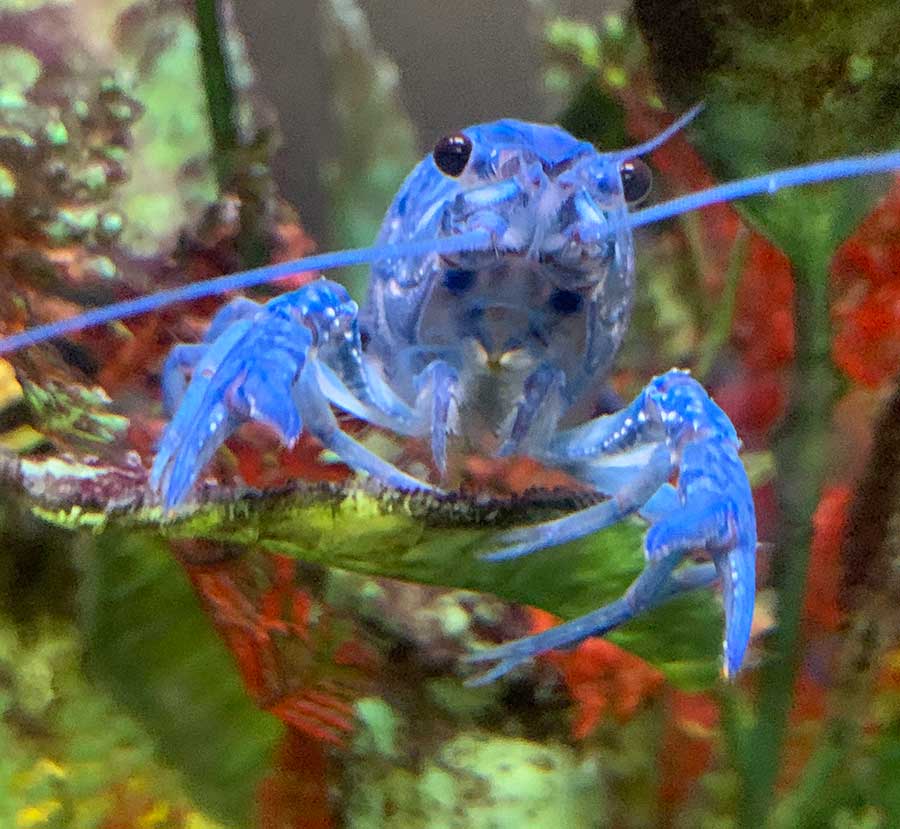
D. Don’t Keep Crayfish Together in Small Tanks
I’d highly recommend not keeping multiple crayfish together in smaller fish tanks as they will constantly be after each other.
If you plan on keeping multiple crayfish in one fish tank, I’d suggest a tank of 50 to 70 gallons or so with multiple hideouts.
I can tell you from experience, if you keep two crayfish in a smaller tank, there will be problems, guaranteed (watch the video above again).
Additionally, you never want to keep two different species of crayfish together in a tank. Just don’t do it.
E. Provide a Hideout
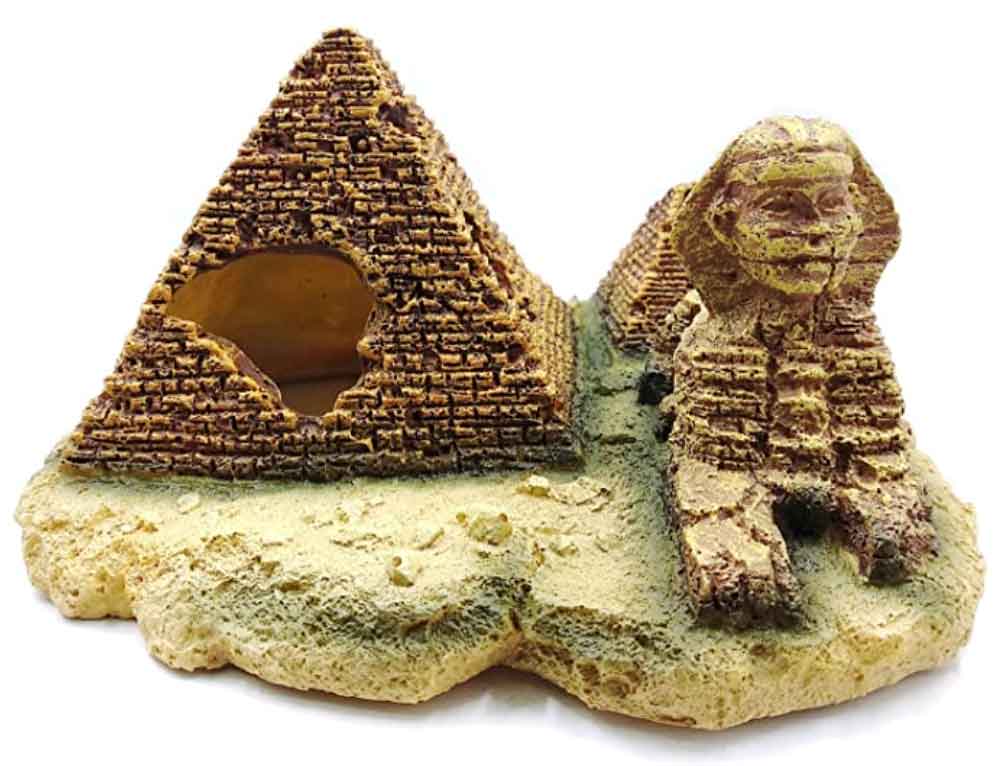
As discussed earlier, blue crayfish need a place to hide out when they are molting.
But, crays also like to burrow. It’s just what they do. So be sure and provide some sort of hideout for your crayfish. A hideout doesn’t have to be anything fancy.
Hideouts can be bought at pet stores or they can be made if you are looking to save a few bucks. Additionally, rocks and driftwood can also work well.
To make your own hideouts, simply buy some one and a half-inch PVC pipe. Cut it into six-inch sections or so and glue aquarium gravel to each piece. When they dry, you can then place them in your aquarium. These make great hideouts for crayfish.
There are some really cool hideouts out there as well. There are vintage cars, pyramids, wrecked ships, makeshift caves, fake logs, and others that can be bought.
Different Types of Crayfish Hideouts
- Old cars
- Makeshift caves
- Fake logs
- Sunken ships
- Castles
- PVC pipe
F. Your Blue Crayfish and Babies
Pet crayfish care can sometimes involve dealing with crayfish babies (see Breeding Crayfish from Home).
When a female crayfish has babies, it involves the male crayfish placing a tiny ball of sperm underneath the belly of the female crayfish. The female crayfish will then pass her eggs through the sperm to fertilize the eggs.
As soon as you notice that you have a female crayfish that will be having babies, remove her from the main fish tank and put her in a separate tank. A 10-gallon tank should work just fine.
Once the crayfish hatch, leave them with the mama crayfish for about three days—but then after three days, you will want to remove them from the tank. If you don’t, you may notice that the female crayfish starts to eat her babies.
As the baby crayfish get larger, you will want to remove the bigger crayfish from the tank as well. This is because they too will eat the smaller crayfish.
PRO TIP: In any tank with crayfish babies, you will want to use a sponge filter.
How to Determine the Sex of Your Blue Crayfish
To determine a crayfish’s sex, you’ll want to flip it over and look underneath. Male crayfish will have an extra set of swimmerets that will be fairly prominent and enlarged. Female crayfish will not have enlarged swimmerets and will have a tiny hole.
G. Keep Your Blue Crayfish with the Right Types of Fish
Different websites will tell you different things about keeping blue crayfish as pets.
Some will say that these very different blue animals are entirely too aggressive to be kept with other freshwater fish. However, I’ve kept my Florida crayfish in a 20-gallon fish tank with a neon tetra and other fish for years now.
The key to keeping these animals with other aquatic life is the type of tank mates you select to be with your crayfish.
You should never choose slow-moving fish or fish that swim on the bottom of the tank to be in a tank with your pet crayfish. There are exceptions to this rule though, like fish that are a little aggressive themselves and can hold their own. But, you have to be careful.
Also, you don’t want fish with big pretty fins swimming around with your crayfish in the tank because your crayfish will do everything it can to nip at those fins, and in the worst case, kill the fish and eat it.
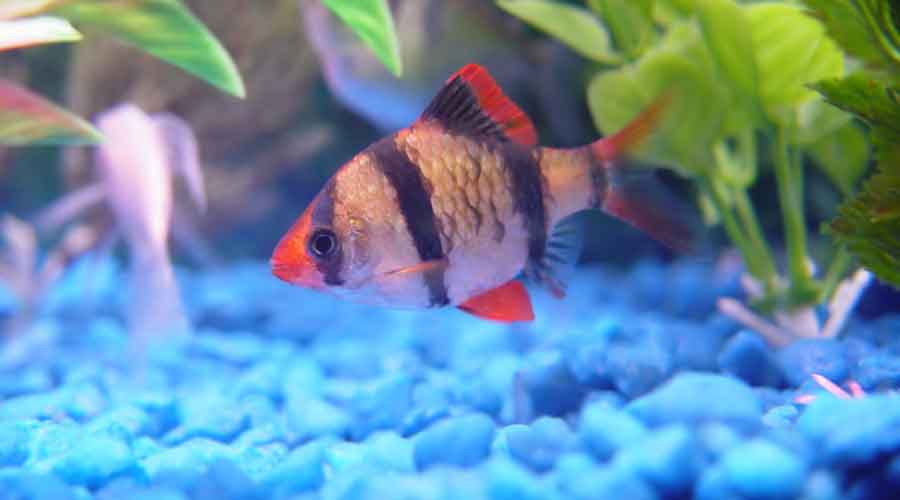
Animals such as snails, plecos, and others will quickly become blue crayfish food if they are placed in the same tank. It’s always best to seek out fast-swimming fish and fish that swim near the top of the tank when looking for blue crayfish tank mates.
Below are a few fish that work well in a tank with crayfish. Keep in mind, since crayfish are already very dirty animals, you have to understand that more fish will add more waste to your tank. In general, you may want to follow the rule of “one gallon of water per inch of fish.” Additionally, adding more fish may mean you have to change your tank’s water more often.
Tankmates for Crayfish:
- Hatchetfish (in my tank)
- Tiger barbs
- Rosy red minnows
- Danios
- Tetras
H: Add Mineral Rocks to Your Tank
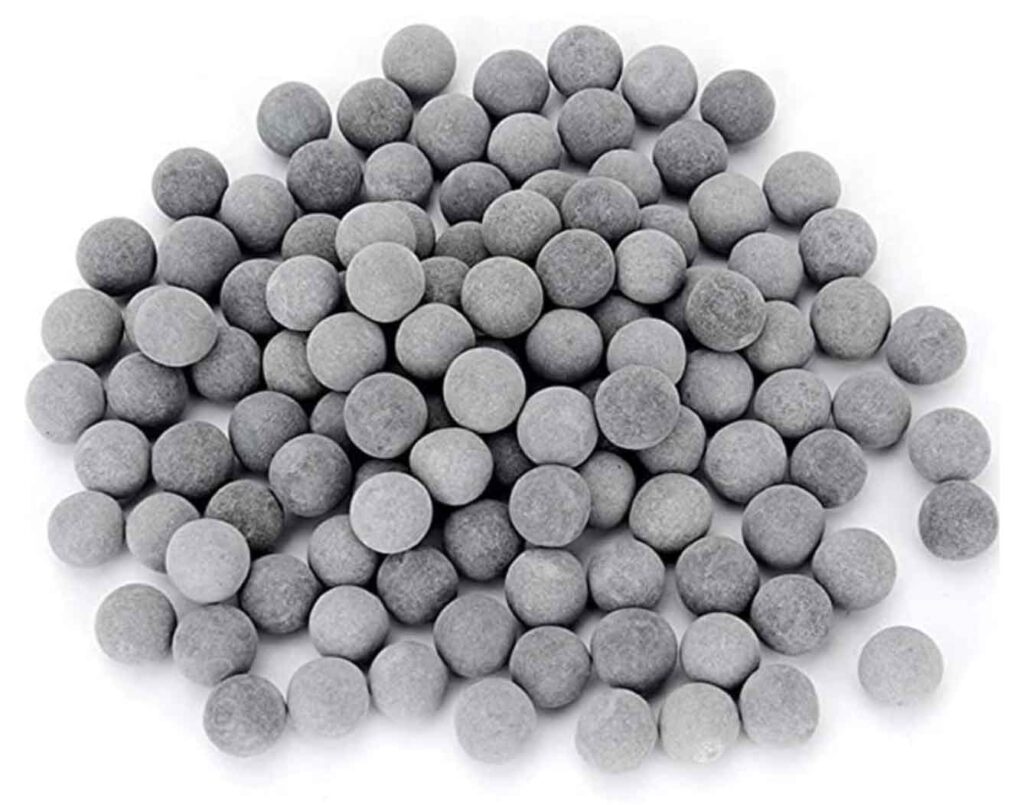
I’d also suggest adding some mineral rocks or tourmaline balls to your crayfish tank.
Mineral rocks contain minerals essential for your crayfish to live a healthy life. Mineral rocks will help your crayfish’s colors to become more vibrant. These minerals also help crayfish to grow stronger exoskeletons after molting.
Mineral rocks are very inexpensive and can have huge impacts on your crayfish.
My first time using them, in just a few short weeks, my crayfish ended up molting and growing the most beautiful new exoskeleton I’d seen. So if you want to include these in your tank, get these mineral rocks. Take a before and after picture for comparison.
I: Will Blue Crayfish Fight?
In a word, yes. In two words, most definitely! Just watch the video above on number 3!
When I first got started keeping crayfish years ago, I made the mistake of trying to keep a white crayfish with a blue crayfish in a 10-gallon fish tank.
Not only was the tank too small, but the white crayfish, who was a lot bigger, ended up devouring the much smaller blue crayfish.
Again, crayfish are aggressive, territorial, and they love to fight.
So, if you are going to keep two crayfish in the same tank, I’d recommend at least a 50-plus gallon fish tank.
I’d also recommend providing plenty of hideouts so your crawfish can comfortably keep to themselves.
J. Can Crayfish Regenerate?
Yes, they sure can. And this is a good thing.
As you know, crayfish are pretty wild. They like to fight with other crayfish and even can lose their claws while battling it out for a mate.
But, it’s no big deal, crayfish can regrow claws and antennae. This usually happens with molting. Sometimes it can even take a couple of molts.
K. Can Crawfish Live Out of Water
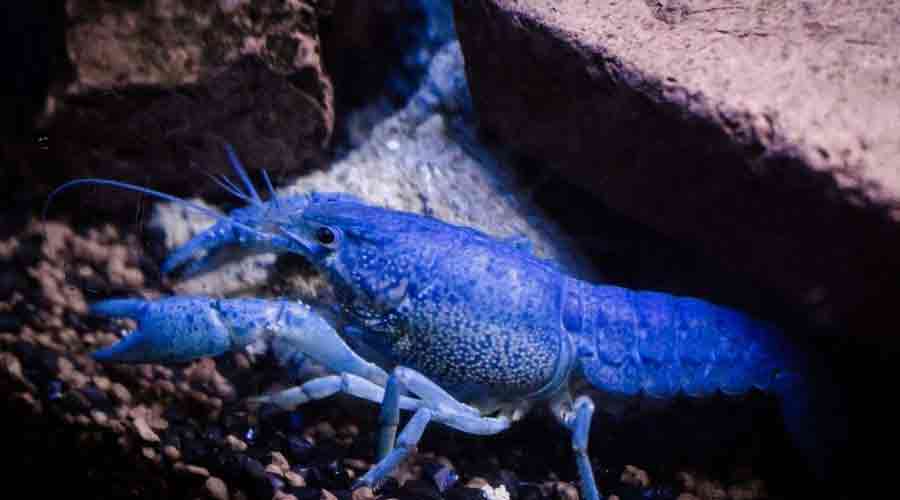
Contrary to what many may think, crayfish can actually live out of water. They have gills that allow them to breathe air, but, these gills need to be kept moist in order to function correctly.
So, if your pet blue crawfish gets out in the house, unless it can find a way to moisten its gills, it will probably die. For this reason, it’s a good idea to keep a towel or some sort of cover on the back of your tank. Make sure all openings are covered.
Blue Florida Crayfish: A Recap
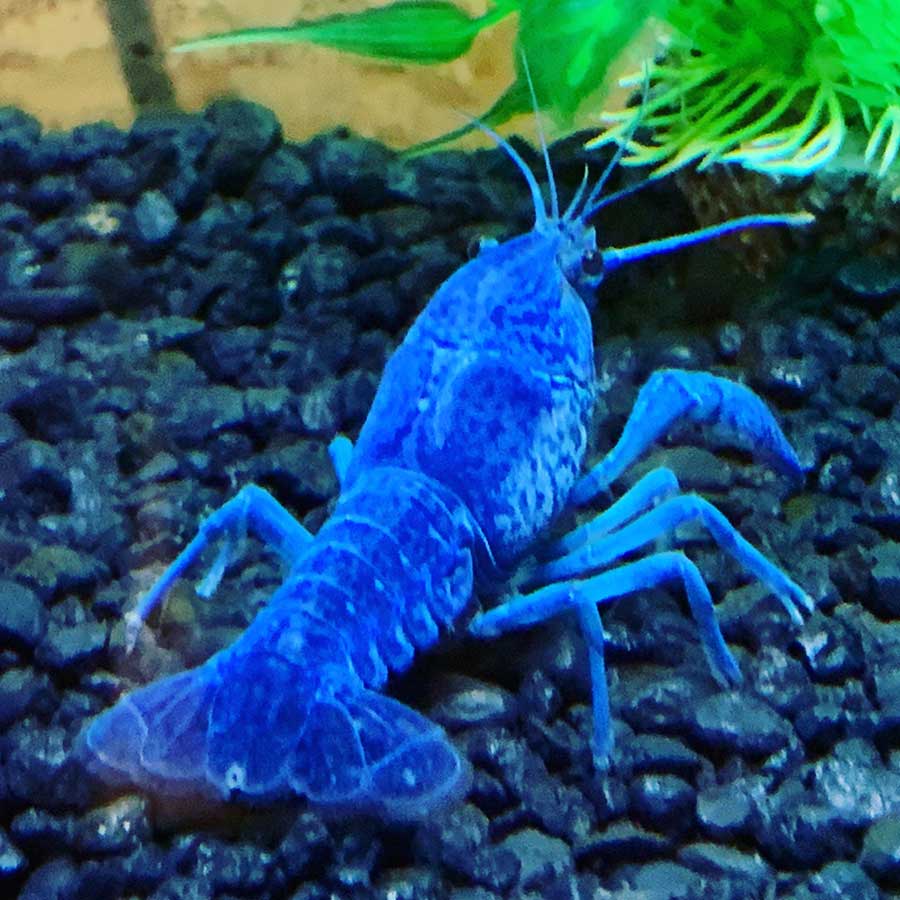
In this blog, I discussed blue crayfish and answered several questions about them.
They are native to Florida and are found in the St. Johns River and the Florida Keys. However, today, we know that blue crayfish can also be found in other states such as Kentucky, Maryland, North Carolina, Ohio, Pennsylvania, Tennessee, Virginia, and West Virginia. Additionally, they are bred and available for purchase all throughout the United States.
Also, it turns out that blue crayfish actually get their amazing color from a genetic defect. Yep, that coloration is 100% all-natural and comes as a result of missing a gene. They’re genetic freaks I guess you could say.
These guys are aggressive in nature. They are omnivores who love to eat both plants and animals.
Basically, these little scavengers will eat anything they can get to. But, they can still be kept as pets and also be kept with other freshwater fish.
However, when keeping these electrifying animals as pets, you will need to keep them in large enough aquariums and select the right types of fish to keep them company.
When it comes to blue crayfish care, other things that are important to take into account are doing regular water changes, not using real plants as decor (suggested), avoiding keeping two crays together in small tanks, and always providing hideouts.
Do you keep blue crayfish currently? What has your experience been?
